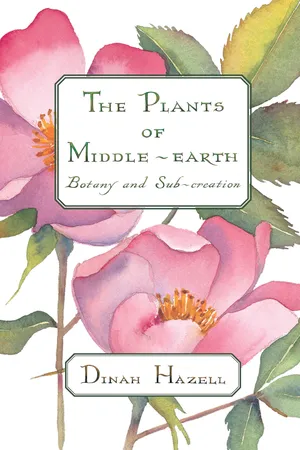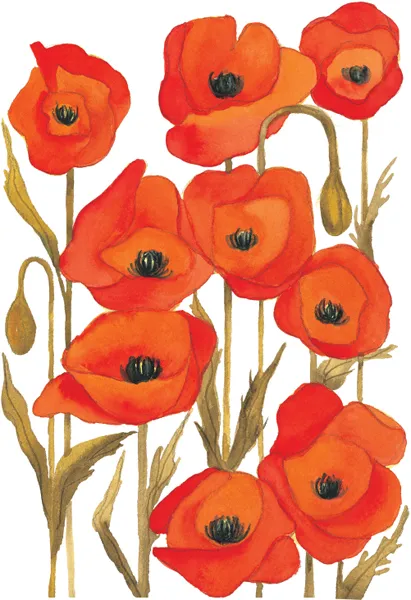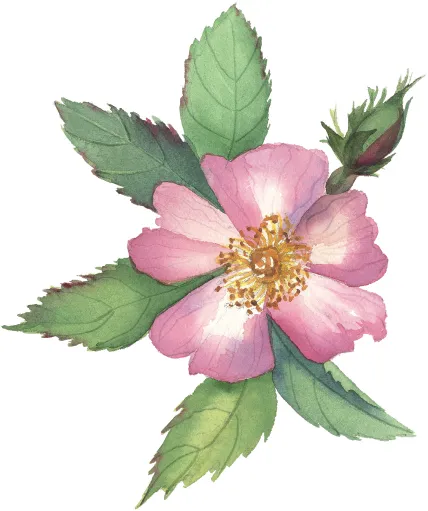The botanical names that abound in hobbit culture give life and color to their namesakes and reflect the close association between folk and flower. Nearly all of Tolkien’s characters (except Men) are unusual or fantastic, and all but hobbits have names created outside of the ordinary to suit their nature. There are a few exceptions: several families of Men bear botanical surnames like Ferny, Goatleaf, Heathertoes, Appledore, Thistlewood, and Rushlight. All are from Bree, the singular community where Men and hobbits dwell together. The most memorable Bree-man’s name is Barliman Butterbur. Although still used as an herbal remedy, butterbur may not be familiar to most modern readers, but it was well known to medieval herbalists, particularly as a cure for pestilential fevers; in Germany it is still called Pestilenzwurz. Its large, broad, round leaves were used for wrapping butter, hence its name. It’s likely that Tolkien chose the name for its sound, as Barliman Butterbur does roll smoothly off the tongue, and its plump namesake is certainly never at a loss for words.
When the four hobbit travelers from the Shire meet some of the Bree-folk at The Prancing Pony, they find the botanical names “odd,”1 apparently forgetting that many Shire women bear floral names. Hobbits find their own names more “natural,” usually related to their living environment, like Burrows and Longholes; some are even more earthy, like Maggot and Grubb. Other popular sources of hobbit names are occupations (as in medieval times), like Roper, Butcher, Sandyman, Greenhand, and Hayward, and physical attributes (real or imagined) like Proudfoot and Goodbody, while a few have plant names, like Mugwort and Cotton. Botanical names are steeped in associations and lore; for example, mugwort (Artemesia vulgaris) was famed in medieval times for its medicinal and magical properties. Mucgwyrt, the “oldest of plants” and “Mother of Herbs”2 protected homes from evil and eased travel weariness, as well as cured illnesses with remedies contained in herbals like the Old English Herbarium and the Anglo-Saxon Lacnunga.3
The Cotton and Gamgee families are closely related in name as well as through friendship and marriage. Although in hobbit history the latter name is derived from the village Gamwich, it actually comes from Gamgee tissue, the name for cotton wool used in Birmingham when Tolkien was young. Gaffer Gamgee was inspired by an odd local character to whom Tolkien gave the alliterated name for comic effect to amuse his children.4
Hobbits are mostly unknown to the rest of Middle-earth, remembered vaguely in myth and needing to be added to Treebeard’s old lists of the lore of Living Creatures. But after being introduced to hobbits, we become accustomed to them quite quickly, overlooking their hairy feet and diminutive size, thanks to their “Englishness”: bright vests, love of food and beer, pipe smoking, and, of course, gardening. Tolkien gave many halflings ordinary names that are easily remembered and visualized, reinforcing the familiarity of the Shire and its inhabitants so that they are always central to the reader.
Before looking at individual hobbit names, a brief discussion of the word hobbit is irresistible. Tolkien claims that it appeared one day unbidden and that there was no linguistic origin for it, although he invented an etymology from Old English (hol: “hole”; bytla: “dweller”); like several other words derived from that language, holbytla is appropriately preserved in Rohan language, which is based on Anglo-Saxon. In Letter 319 Tolkien considers the possibility that hobbit might have come from an unconscious childhood memory of characters in a story (one of several theories offered by readers) but thinks it unlikely.5 However, it is tempting to imagine that the word was buried in his memory, a bit of the “leaf-mould” that occasionally surfaces,6 and we may look to Middle English literature for clues. The words hob and hobbis appear in several fourteenth-century works, like The Mum and the Sothsegger and Richard the Redeless, which are approximately contemporary with the Gawain-poet’s works Tolkien translated. Not all definitions of hob and hobbis glossed by scholars apply here, but several seem quite relevant: a rustic, one of common class, a country clown. While hardly capturing the full hobbit nature, these descriptions hint at the kernel of the mysteriously appearing name for rural beings who can be “comic” and “laughable,” especially Sam’s “comicness, peasantry” and “Englishry.”7
Most botanical hobbit names are women’s given names, like Poppy, Daisy, and Primula. The Entish reluctance to divulge one’s true name reflects the universal belief that names hold the essence of a person’s nature and once revealed can confer power over the owner. Conversely, attributes can be bestowed through name giving, and floral names bequeath not only loveliness but also virtues associated with the bloom or plant. Perhaps a flower name was chosen for a hobbit maid-child because it brought back some memory, like Aragorn’s thoughts of Arwen as he gazed on a golden elanor blossom in Lothlórien,9 or maybe just because it was a favorite.
What’s in a Name?
While Tolkien often chose words for their sound, a close look at many of them suggests that meaning had more influence than might be suspected or claimed. For example, names he gave to his dwarves from the Elder Edda, when translated from the Old Norse, fit their owners’ characteristics quite well. Thrain is translated as Yearner, descriptive of a dwarf who is restless and greedy for gold; Gloin (ON Gleamer) is chief fire-maker, with his brother, of the dwarves; Thror (Thrive) is head of the dwarf dynasty; Thorin (Darer) leads the dwarves into battle; Durin (Doorward) holds the secret to entering Moria; and Bombur (Tubby) needs no explanation.8
It’s obvious that Tolkien, like Bilbo, loved flowers, and it seems he wished to portray the spirit of Shire women through that sweet, occasionally thorny, timeless imagery. A bouquet could be gathered from hobbit female names, or they might decorate a medieval illumination like those in the manuscripts Tolkien studied. Now, we will look at some of the flowers for which hobbit women are named. Although we don’t know many of the characters well, we can imagine what parents hoped for in their daughters, and, with characters we do know, whether they grew into their names. And even if given (by hobbit parents or Tolkien) without deliberate purpose, a name is still evocative. The two hobbit women we know best are Lobelia Sackville-Baggins and Rosie Cotton, so we’ll start with them.
Lobelia Sackville-Baggins
Lobelia is one of the few flowers used by Tolkien that does not have a lengthy history. Introduced in the eighteenth century from Africa and the Americas, it was not cultivated extensively in England until the nineteenth century. There are over two hundred varieties of lobelia, annual and perennial, wild and cultivated, ranging from small clumping and trailing plants that reseed themselves throughout the garden (often in unwanted places like between bricks in pathways), to sturdy spiking stalks, all in vivid colors. The upright varieties, such as Lobelia cardinalis, sleep over the winter but reemerge each spring in readiness for bright summer bloom. Lobelia’s last name is reminiscent of Vita Sackville-West, designer of the great garden at Sissinghurst Castle planted from 1930 onward, and might be a tribute to her, or perhaps it’s a satirical poke at Lobelia’s visions of grandeur.
Rosie Cotton
Unlike the newcomer lobelia, the rose, which grew in abundance in Tolkien’s garden,10 is laden with history and symbolism. Roses have been prized since at least Roman times and developed over the ensuing centuries, but many of the roses we now see are “modern” roses, developed in the last two centuries. For many of us, the best rose is the “old” rose. And the most ancient cultivated old roses are the Gallicas, perhaps introduced to Britain by the Romans and known to the Anglo-Saxons, with many varieties today. The R. Gallica officinalis, also called the apothecary’s rose for its medicinal uses, is probably the oldest of the Gallicas. It is the red rose of the Lancasters, as opposed to the white Rosa alba of the Yorks. Another old rose family is the heavily scented Damask, which tradition holds was brought to England by returning Crusaders.
There are two roses native to Britain that are easily envisioned in Middle-earth. One is the Rosa canina (briar, dog rose, wild rose), which was one of William Morris’s favorites and appeared in his garden, designs, and verse. It grows to around ten feet and can be cultivated as a dense shrub or on trellises. Although it has waned in popularity as more showy roses have taken prominence and is now used as root stock for hybridizing, it still graces the English countryside in hedgerows.
The other is the sweet briar, Rosa eglanteria. Like the Rosa canina, it can climb up trellises and through hedges. It has a decidedly “Tookish” nature, like the family famous for its adventurousness (the usually complacent Bilbo was spurred on by his Tookish side).11 One of the most treasured wild plants in England, it is loved for its apple-like scent, predominant in its leaves; due to its aroma and piercing thorns, the sweet briar represents pleasure and pain. Eglantine Took, Pippin’s mother, is not the only namesake of this flower; readers of Chaucer will recognize one of his most controversial characters, Eglantine the Prioress. Scholars debate over this choice of name; one widespread theory is that it is taken from medieval romance heroines and thus inappropriate for a clergywoman, and other suggestions include association with a historic person or the flower and possible Christian connotations.
The rose has wide, sometimes conflicting symbolism. It represents love and secrecy, transient love, change and mutability, steadfastness, religious devotion, and purity. Along with the lily, it is dedicated to the Virgin Mary, and the rosary takes its name from the compressed petals that once formed the beads.
Despite its delicate beauty and reputation for touchiness, the rose is remarkably hardy. Many will thrive with little or no care, and an unwanted plant can be very difficult to retire; once firmly rooted, it will persevere. While there are countless roses, they escape commonality and are treasured, as is Rosie Cotton by Sam, who comforts himself during hardship with thoughts of her and her brothers in happier days.12
Daisy Gamgee and Daisy Boffin
Tolkien’s career as an artist was as long, and nearly as productive, as his literary. He did few naturalistic floral illustrations; rather, flowers appear as design elements in heraldic devices and floral alphabets. But his early work, drawn from his surroundings, featured landscapes, buildings, and trees, a focus maintained in the details of The Lord of the Rings. Like William Morris, whose literary technique and themes were among Tolkien’s inspirations and with whom he shared a love of medievalism, a disdain for modern technology and industrialization, the desire to protect forest and trees, and a preference for homely craft, Tolkien chose flowers that graced the fields and woods in which he spent his youth and treasured throughout his life. One such is the daisy, a favorite motif of Morris’s designs. Morris was also a famous gardener, influential in the cottage style developed in the late nineteenth century based on free-flowing, traditional native plantings rather than rigid compositions of ornamental hybrids and exotics.
There are many varieties of daisies, so the image will vary depending on the reader’s locale and environment. But let’s concentrate on one used by Morris, with the thought that it might also be the bloom envisioned for Middle-earth: the Bellis perennis or English daisy, a miniature white bloom tinged with pink, found in lawns. Today, there are two dozen forms of Bellis perennis, many of which were cultivated by the eighteenth century; Elizabethan gardeners collected double forms and the “hen and chickens” in which small blossoms ring the main flower,13 with which Tolkien was familiar. In Letter 312, Tolkien tells of some red daisies in his border garden that reseeded into the grass, where they becam...


